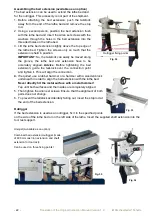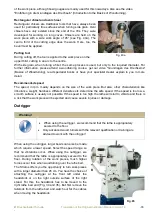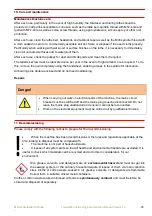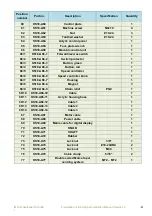
©
Drechselbedarf Schulte
-
Translation of the Original Instruction Manual Version 1.0
- 33
of the work piece, although bowl gouges are mainly used for this nowadays. Also see the video
"Einführung in die Grundlagen des Drechseln" (Introduction to the Basics of Woodturning).
Rectangular chisel and oval chisel
Rectangular chisels are traditional tools that have always been
used for particularly fine surfaces when turning side grain. Oval
chisels have only existed since the end of the 70s. They were
developed for working on long coves. Chisels are held on the
work piece with a side work angle of 45° (see Fig. 40a). The
centre third of the cutting edge does the work. Here, too, the
bevel must be applied.
Parting tool
During cutting off, the tool is applied to the work piece on the
upper third, cutting in an arc to the centre.
Fig. 40a
With side grain, when turning a fillet, the same process is used, but only to the required diameter. For
further information, please attend a woodturning course, get our video "Grundlagen des Drechselns"
(Basics of Woodturning), read specialist books or have your specialist dealer explain to you in more
detail.
Recommended speed
The speed, in rpm, mainly depends on the size of the work piece. But also, other characteristics like
imbalance, weight, hardness, different densities etc. determine the safe speed. If the speed is too low, a
smooth surface is usually not possible. If the speed is too high, the lathe will start to vibrate and there is
a risk that the work piece will be ejected and cause severe injuries or damage.
Outrigger
Warning!
•
When using the outrigger, we recommend that the lathe is appropriately
secured to the floor.
•
Only advanced wood turners with the relevant qualification or training are
advised to work with the outrigger!
When using the outrigger, larger bowls can also be made
which require a lower speed. Select the speed range so
that no vibrations occur. When using the outrigger, we
recommend that the lathe is appropriately secured to the
floor. During rotation of the work pieces, much higher
forces occur than when woodturning over the lathe bed.
The Stratos offers you the opportunity to turn work pieces
with a larger diameter than 45 cm. You have the choice of
attaching the outrigger at the front left under the
headstock or on the right outside surface of the right
stand. For this, the headstock has to be moved to the
right lathe bed end (Fig. 34 and 35). But first remove the
tailstock from the lathe bed and watch out for the cables
when moving the headstock.
K
D
Fig. 65
Содержание FU-230
Страница 1: ...FU 230 WOOD TURNING LATHE...

































